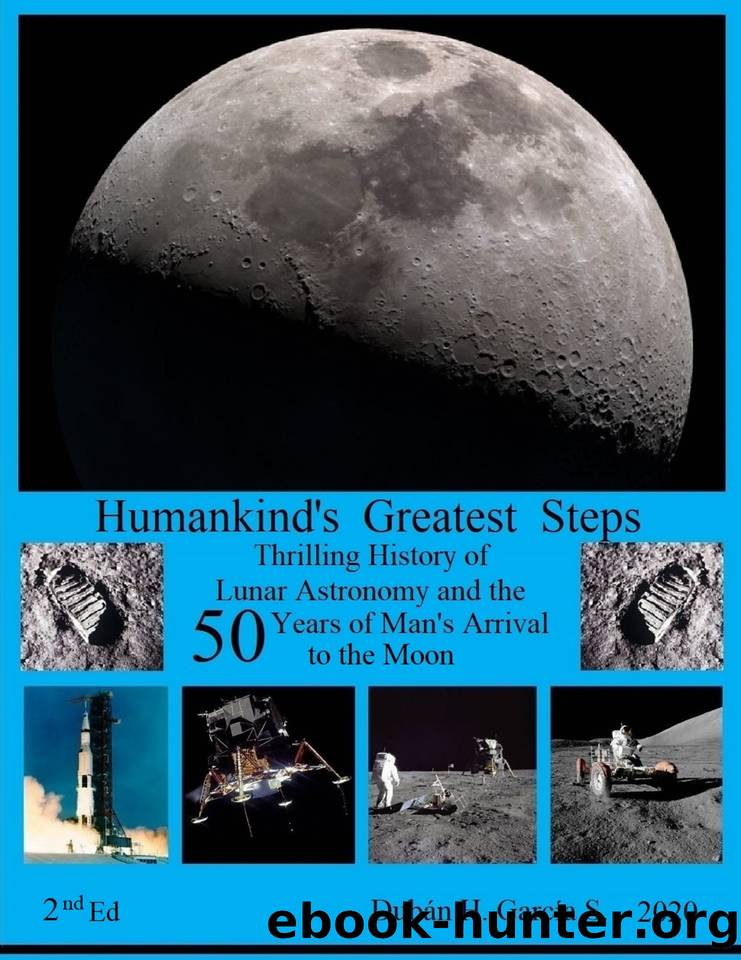Humankind's Greatest Steps: Thrilling History of the Lunar Astronomy and the Fifty Years of the Arrival of Man to the Moon. 2ª Edt. by García S. Dubán H

Author:García S., Dubán H. [García S., Dubán H.]
Language: eng
Format: epub
Published: 2020-08-05T16:00:00+00:00
Image 6.2
Lunar Elliptical Orbit
Johannes Kepler extended his Laws of Planetary Motion to explain the kinematics of natural satellites around their respective planets.
Also in the Epitome this astronomer argued on the theory of eclipses and explained why the Moon seems to be illuminated by a weak reddish light during total eclipses: he rightly supposed that sunlight, when crossing through the terrestrial atmosphere, it deviates from its path to reach the satellite and then to be reflected. Likewise, Kepler dealt with the total eclipses of the Sun, he trated with the luminous brightness that appears around the King star’s globe during these phenomena and cited what was previously stated by Plutarch: “ The Moon sometimes obscures the Sun completely, but always for a short time, and it is never large enough to prevent a certain luminosity from appearing around the circumference of the Sun, which makes the darkness never black and deep nor completely dark .” 4 What is constituted in the first historically recorded considerations on the solar corona.
Other Keplerian Works
Although they were contemporaries, Kepler and Galileo never met personally; but each was well informed about the other’s works and they often written themselves. On April 8, 1610, Kepler finally got the edition of Galileo’s little book, Sidereus Nuncius , or Sidereal Messenger, which was sent to him by the own author. In some forty pages Galileo gives a very precise description of his telescopic observations and states that he has seen amazing things in the sky, so he asks the German astronomer for his interpretations. Kepler responded publicly in 1610 with a booklet called Dissertatio cum Nuncio Sidereo , or Dissertation about the Sidereal Messenger , praising him for his constructed telescopes and for the discoveries made with them, as well as adding own interpretations and hypotheses, all within the framework of the Heliocentric theory.
For great disappointment of the German astronomer, the hypothesis of fixing the orbits of the planets inside perfect polyhedrons, or Platonic Solids, as he had done in his first work Cosmographic Mystery, never worked. Harmonices Mundi, or The Harmony of the World of 1619, is a book written by Kepler where he began exposing this theory, to finally show that it is incompatible with the astronomical observations and with the two laws of planetary movement exposed by him in his New Astronomy , so he ended rejecting it . The third law, which indicates that the cube of the average distance from the planet to the Sun is proportional to the square of its orbital period, is newly presented in chapter 5 of The Harmony of the Worlds . Additionally, in this work Kepler tried to justify the planetary movements from the causal point of view, postulating a force similar to magnetism which he thought emanated from the Sun.
The Rudolphine tables are planetary and stellar datasets collected by Kepler from the astronomical observations made by Tycho Brahe; they are presented in tabular form and were widely used by astronomers around the world for more than a century to determine celestial movements and so to calculate the positions of planets and stars.
Download
This site does not store any files on its server. We only index and link to content provided by other sites. Please contact the content providers to delete copyright contents if any and email us, we'll remove relevant links or contents immediately.
| Africa | Americas |
| Arctic & Antarctica | Asia |
| Australia & Oceania | Europe |
| Middle East | Russia |
| United States | World |
| Ancient Civilizations | Military |
| Historical Study & Educational Resources |
The Third Pole by Mark Synnott(906)
Money for Nothing by Thomas Levenson(890)
The Economist (20210109) by calibre(888)
Christian Ethics by Wilkens Steve;(818)
Made in China by Anna Qu(802)
The Age of Louis XIV: The Story of Civilization by Will Durant(781)
Reopening Muslim Minds by Mustafa Akyol(761)
Nonstate Warfare by Stephen Biddle(756)
100 Posters That Changed The World by Salter Colin T.;(744)
The Shortest History of China by Linda Jaivin(712)
The Great Pyramid Void Enigma by Scott Creighton(711)
The Irish Buddhist by Alicia Turner(707)
Culture by Terry Eagleton(698)
Ideology by Eagleton Terry;(687)
Routledge Handbook of Contemporary India by Knut A. Jacobsen(685)
Sybille Bedford by Selina Hastings(648)
The Jews of Silence: A Personal Report on Soviet Jewry by Elie Wiesel(640)
Objects of Vision by Saab A. Joan;(629)
Banaras: CITY OF LIGHT by Diana L. Eck(624)
